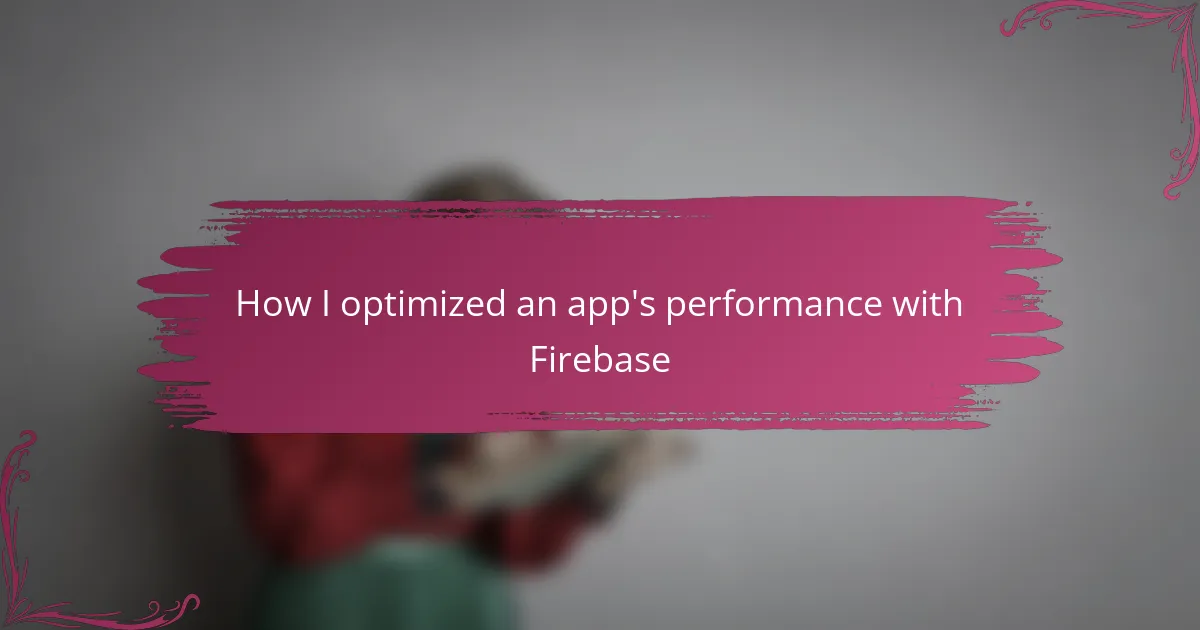Key takeaways Visual Studio Code (VS Code) is a free, customizable code editor that integrates advanced features like debugging and intelligent code completion, enhancing the coding experience. It offers cross-platform support, ensuring a consistent user experience across Windows, Mac, and Linux, which simplifies project management. Preparing the Windows system, downloading from the official site, and […]

How I optimized an app’s performance with Firebase
Key takeaways Firebase combines multiple development tools, simplifying app building and scaling with features like real-time databases and performance monitoring. Optimizing app performance is essential, as even minor delays can lead to user frustration; tools like Firebase Performance Monitoring help identify key bottlenecks. Regular testing across various devices using Firebase Test Lab reveals performance inconsistencies […]

How I fixed build errors in Xcode
Key takeaways Build errors in Xcode stem from issues like missing files, incompatible library versions, or incorrect settings. Utilizing tools like the Issue Navigator, build logs, and console output can greatly aid in diagnosing and resolving errors. A systematic approach to troubleshooting—reading error messages carefully, performing clean builds, and isolating changes—can lead to more effective […]

How I tested my code with PHPUnit
Key takeaways PHPUnit enhances code clarity and developer confidence by catching issues early, acting as a safety net for code changes. Setting up PHPUnit is simple and encourages maintaining an organized testing environment, which streamlines the testing process. Writing descriptive test cases and using data providers improves test maintainability, reduces redundancy, and facilitates easier debugging. […]

This is how I managed my API keys securely
Key takeaways Treat API keys as sensitive information, protecting them with the same care as passwords to prevent unauthorized access. Implement best practices such as avoiding hardcoding keys, limiting permissions, and conducting regular key rotation for enhanced security. Utilize dedicated tools like secrets managers and automation for efficient API key management and to minimize the […]

This is how I installed Python on Windows
Key takeaways Python is praised for its readability and versatility, making it accessible for both beginners and experienced programmers. The installation process on Windows is user-friendly and customizable, allowing options like adding Python to the system PATH for smoother usage. Verifying the installation through the command line and configuring environment variables are crucial steps in […]

This is how I improved my Node.js applications
Key takeaways Understanding Node.js’s event-driven, non-blocking I/O model can significantly improve server-side application performance. Setting specific performance goals and tracking key metrics helps in effectively optimizing applications and improving user experience. Implementing code optimization techniques, such as memoization and using async/await, can enhance application speed and readability. Monitoring performance with real-time metrics and adopting security […]

My thoughts on using Figma for UI design
Key takeaways Figma’s real-time collaboration and cloud-based accessibility greatly enhance teamwork and flexibility compared to other tools like Sketch and Adobe XD. Mastering components, variants, and the auto-layout feature can substantially improve consistency and efficiency in design workflows. Consistent naming conventions and leveraging asset libraries help manage complex projects and minimize confusion. Utilizing plugins can […]

My thoughts on automating deployments with Jenkins
Key takeaways Deployment automation enhances reliability and efficiency, allowing developers to focus on building features instead of managing repetitive tasks. Jenkins, as an open-source platform, offers flexibility through plugins and an intuitive interface for monitoring deployments. Best practices include keeping pipelines simple and modular, managing credentials securely, and using version control for job configurations. Common […]

This is how I created a portfolio website with Wix
Key takeaways A portfolio website is a crucial reflection of your skills and personal brand, serving as a storytelling platform for your creative journey. Wix offers an intuitive, user-friendly approach to website building, allowing for easy customization without coding knowledge. Effective content preparation is essential; focus on clarity and select key projects that represent your […]
